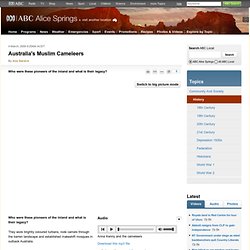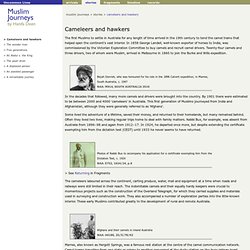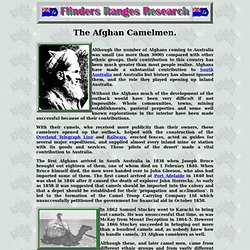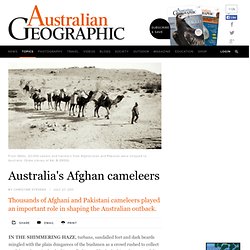

Intersections of identity - Afghan cameleers. Muslims in Australia Doco Trailer #2 Afghans. Australia's Muslim Cameleers - ABC Alice Springs. Who were these pioneers of the inland and what is their legacy?

They wore brightly coloured turbans, rode camels through the barren landscape and established makeshift mosques in outback Australia. A new exhibition at the Araluen Arts Centre in Alice Springs explores the impact and contribution of Australia's Muslim Cameleers throughout inland Australia including the Centre. Local anthropologist and co-curator Anna Kenny has enthusiastically watched the exhibition travel around Australia over the past two years.
"I hope people realise (from seeing the exhibition) that Australia has had a longstanding Muslim history and that our national development, especially culturally, benefitted a lot from them being here, especially in Central Australia where they brought the telegraph poles," says Kenny. ReCollections - Australia's Muslim cameleers: Pioneers of the inland, 1860s-1930s. Australia's Muslim cameleers: Pioneers of the inland, 1860s-1930s Despite earning praise for their low-fat and low-cholesterol meat, camels in Australia today are labelled a pest, in some cases of plague proportions.

There was a time, however, when they were the backbone of Australia's outback economy. The building of the Overland Telegraph Line, Trans-Australian railway, and services to outback communities and properties all depended on them. There are also few introduced species that arrived with such a distinctive human community and culture. Muslims in Australia Doco Trailer #2 Afghans. Cameleers and hawkers - Uncommon Lives. The first Muslims to settle in Australia for any length of time arrived in the 19th century to tend the camel trains that helped open the continent's vast interior.

In 1858 George Landell, well-known exporter of horses to India, was commissioned by the Victorian Exploration Committee to buy camels and recruit camel drivers. Twenty-four camels and three drivers, two of whom were Muslim, arrived in Melbourne in 1860 to join the Burke and Wills expedition. Bejah Dervish, who was honoured for his role in the 1896 Calvert expedition, in Marree, South Australia, c. 1947 In the decades that followed, many more camels and drivers were brought into the country. By 1901 there were estimated to be between 2000 and 4000 'cameleers' in Australia. Some lived the adventure of a lifetime, saved their money, and returned to their homelands, but many remained behind. Photos of Nabbi Bux to accompany his application for a certificate exempting him from the Dictation Test, c. 1924 NAA: E752, 1924/24, p.9. Afghan Camelmen South Australian History. Although the number of Afghans coming to Australia was small (no more than 3000) compared with other ethnic groups, their contribution to this country has been much greater than most people realise.

Afghans have made a substantial contribution to South Australia and Australia but history has almost ignored them, and the role they played opening up inland Australia. Without the Afghans much of the development of the outback would have been very difficult if not impossible. Whole communities, towns, mining establishments, pastoral properties and some well known explorations in the interior have been made successful because of their contributions. With their camels, who received more publicity than their owners, these cameleers opened up the outback, helped with the construction of the Overland Telegraph Line and Railways, erected fences, acted as guides for several major expeditions, and supplied almost every inland mine or station with its goods and services.
In 1880 Sub Inspector B.C. Australia: Intersections of identity. Origins and arrival of cameleers « Australia's Muslim Cameleers. Known in Australia as ‘Afghans’, the cameleers came mainly from the arid hills and plains of Baluchistan, Afghanistan and the north-west of British India (today’s Pakistan).

The cameleers belonged to four main ethnic groups: Pashtun, Baluchi, Punjabi, and Sindhi. Despite cultural and linguistic differences, the cameleers shared ancient skills. In their homelands many led semi-nomadic lives, carrying goods by camel string along centuries-old trade routes through arid and harsh regions of Central Asia. Afghan cameleers: Australia's outback history. IN THE SHIMMERING HAZE, turbans, sandalled feet and dark beards mingled with the plain dungarees of the bushmen as a crowd rushed to collect mail from the train that had just pulled in.

Suddenly the hiss of steam and the excited babble were punctuated by the sound of gunshots. An Afghan fell to the ground, wounded. Another swiftly and silently slipped away into the surrounding desert. The place was Marree, South Australia; the year was 1904. Early one hot December morning in 1986, I recalled that story as I sat under sparse shade in a dry, red-soil creek bed at Farina, 50 kilometres from Marree. As we sat in the creek bed, sipping from Charlie's cool water-bag I tried to picture the nearby barren hillock as it had been in 1904 when occupied by tin huts, camel-yards, a simple mosque and an entire Afghan community. Only a few weeks before, the young cameleer had been betrothed to a girl of 14 from the Marree Ghantown. Birdsville cameleer. Afghan Cameleers In Australia.